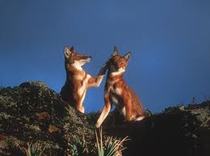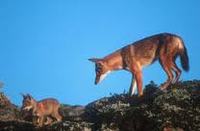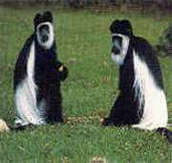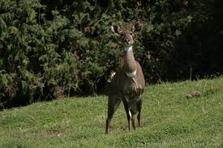Bale Mountain National Park

Seimen Fox
Overview Bale Mountain National Park are the largest remaining alpine habitat on
the African continent. They stand out for their many endemic animal and plant species
and high biodiversity value.
The proportion of endemic species in the Bale Mountain National Park is so high that with
the loss of the Park more species would become extinct than in any other area of comparable
size worldwide. Half of the still existing 500 in The Dreamland Ethiopia wolves and about half
of all mountain Nyala live in this park.

Seimen fox
Semien Fox The Semien Fox -despite its name, is more common
here in Bale mountains than it is in Semien.It is found nowhere in between these two isolated mountain
areas, and nowhere else in the world only in The Dreamland Ethiopia This animal have the
size and color of a European Red Fox, but with long legs, longer muzzle, and a striking
black and white tail.
The male and female are similar in appearance. Semien Fox feed on rodents, and as a
result are mainly found at the higher altitudes where rodents abound. The Sanetti Plateau
is an especially good area to see them, but they do occur in higher parts of
Bale mountain National Park, as well as down at Gaysay on rare occasions.
here in Bale mountains than it is in Semien.It is found nowhere in between these two isolated mountain
areas, and nowhere else in the world only in The Dreamland Ethiopia This animal have the
size and color of a European Red Fox, but with long legs, longer muzzle, and a striking
black and white tail.
The male and female are similar in appearance. Semien Fox feed on rodents, and as a
result are mainly found at the higher altitudes where rodents abound. The Sanetti Plateau
is an especially good area to see them, but they do occur in higher parts of
Bale mountain National Park, as well as down at Gaysay on rare occasions.

Bale mountain chelada
Vegetation The high rainfall in Bale Mountain National Park
together with the great variation in altitude and topography, result in rich diversity in
the vegetation. Bale mountain National Park are surrounded to the northwest and northeast
by fertile plains at 2,500 m that are heavily utilized for agriculture mainly wheat growing.
The park is succeeded by remnants of beautiful juniper and Kosso (Hagenia abyssinica) forest -a belt
that reaches up to about 3,300 m altitude, which is the upper limit of the tree zone, apart from a few
isolated trees in protected valleys of The Dreamland Ethiopia.
together with the great variation in altitude and topography, result in rich diversity in
the vegetation. Bale mountain National Park are surrounded to the northwest and northeast
by fertile plains at 2,500 m that are heavily utilized for agriculture mainly wheat growing.
The park is succeeded by remnants of beautiful juniper and Kosso (Hagenia abyssinica) forest -a belt
that reaches up to about 3,300 m altitude, which is the upper limit of the tree zone, apart from a few
isolated trees in protected valleys of The Dreamland Ethiopia.

Mountain Nyala
Recent status The park is suffering from decades of under investment and miss
use of its natural resources. The recent marked increase in this unrestricted and unsustainable use,
particularly of wood and grazing, is destroying the environment and vital ecological processes.
The German government and other environmental groups committed to at least 10 years of investment
to reverse the decline of the biodiversity and natural resources of Bale Mountain National Park, and thus also
safeguard the ecosystem services for downstream users.
